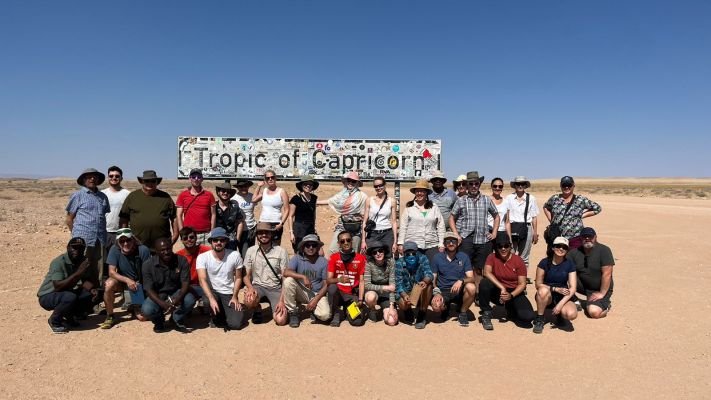"Inside Africa": A Two-Week Training Field Trip in Namibia Unveiled
24 May 2023

Namibia, renowned for its exceptional natural landscapes and geological wonders, recently hosted an exciting two-week training field trip titled "Inside Africa" (06-20 May 2023). This program organised by the ITN aimed to provide invaluable training to 15 PhD students specializing in Earth and environmental sciences. Focused on Earth's surface dynamics, the training delved into the intricate link between erosion processes, sediment production, and the ultimate deposition of sediments—a scientific pursuit commonly referred to as source-to-sink (S2S) approaches.
The unique characteristics of Namibia made it an ideal location for this comprehensive training. Three key aspects took center stage during this captivating program:
1. Alluvial and Diamond Source-to-Sink Systems The training delved into the study of alluvial source-to-sink systems, with a particular emphasis on the renowned Orange River. This river system offered a wealth of knowledge on erosion processes and sediment production. Additionally, participants explored the intriguing diamond source-to-sink systems found in the Sperrgebiet, unlocking the secrets of these precious gems.
2. Explored Aeolian Source-to-Sink Systems Namibia's diverse landscapes also offered an excellent opportunity to study aeolian source-to-sink systems—those shaped by wind. By comparing the modern Namib systems with two fossilized counterparts from the Miocene (Namib) and the lower Cretaceous (Twyfelfontein), participants gained valuable insights into the evolution and dynamics of these systems throughout time.
3. Unraveled the Growth of Anorogenic Relief The training program showcased the remarkable growth of anorogenic relief in Namibia, presenting a captivating study of escarpments, plains, and plateaus. Participants explored the impact of various geological phenomena, including the Late Paleozoic Ice Age, the Parana-Etendeka Large Igneous Province resulting from ocean opening, and the mantle-controlled uplift known as the Southern Africa Plateau.
In addition to these three primary areas of focus, the training briefly touched upon the modern hyperarid Kuiseb River. Participants examined the frequency of floods and sediment transport within this remarkable river system.
Through a combination of fieldwork, lectures, and interactive sessions, this two-week training field trip proved to be a transformative experience for the 15 PhD students. They acquired specialized knowledge in Earth and environmental sciences, honed their research skills, and developed a deep understanding of source-to-sink approaches. Moreover, the stunning landscapes and geological wonders of Namibia provided an awe-inspiring backdrop for their scientific endeavors.
"Inside Africa" served as a stepping stone for these aspiring researchers, equipping them with the expertise to contribute meaningfully to the field of Earth and environmental sciences. As they embarked on this thrilling journey, groundbreaking discoveries and insights were eagerly anticipated from this extraordinary training experience in Namibia.



